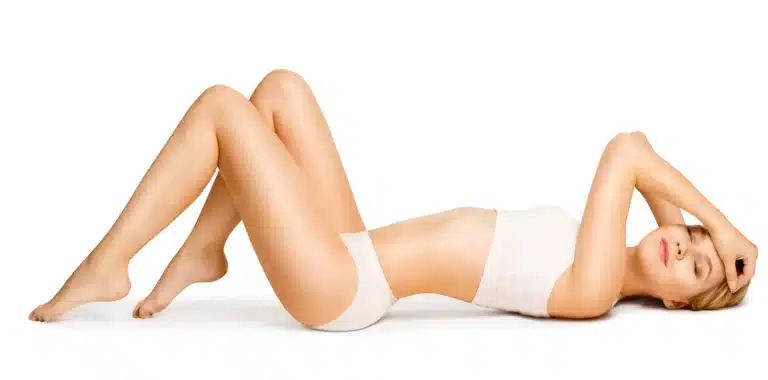Home » Conditions » Body » Saddlebags
Saddlebags désigne un amas graisseux localisé sur les hanches, le haut des cuisses et parfois les fesses, formant une sorte de “poche” disgracieuse qui modifie la silhouette féminine.
Rare chez les hommes, pour des causes hormonales et génétiques, il s’agit d’un vrai complexe pour les femmes.
Même avec une alimentation équilibrée et de l’exercice physique, cette zone peut être particulièrement difficile à affiner. La culotte de cheval est souvent perçue comme un problème esthétique, car elle donne un aspect disproportionné au bas du corps.
En réalité cela n’a pas d’effet. En médecine morphologique et anti-âge Certaines techniques médicale permettent de getting rid of saddlebags without surgery.
Treating saddlebags with aesthetic medicine techniques represents a modern and effective solution for women looking to slim down this stubborn area. Thanks to non-invasive techniques such as cryolipolysis and radiofrequency, it
is possible to reshape the figure harmoniously and reduce saddlebags. Each method is personalized according to the patient’s needs and expectations, offering visible and long-lasting results without major intervention.

From a histological point of view, saddlebags are made up of fat cells separated by collagen fibers that are often thickened and disorganized — this is known as fibrosis. Water retention is frequently associated.
In this area, we often find :
• Excess fat and adipose cellulite.
• Fibrosis and fibrous cellulite.
• Water retention and edematous cellulite.
Saddlebags result from several combined factors :
• Hormonal factors : estrogens, the female hormones, promote fat storage in this area, especially during puberty, pregnancy, or menopause.
• Genetic factors : fat distribution is genetically determined. This explains why even slim, athletic women with a healthy lifestyle can have saddlebags !
• Lack of targeted exercise : physical activity is beneficial for health, but specific exercises must be done to reduce fat accumulation in this area.
• Sedentary lifestyle and diet : an unbalanced diet rich in saturated fats and sugars, along with a lack of physical activity, are aggravating factors.
• Caloric surplus : when the calories consumed exceed those burned, the body stores the excess as fat. In women, this storage occurs mainly in the lower body (gynoid body type).
Certain simple habits and activities help reduce saddlebags :
• Maintain a healthy diet : one that is rich in fiber, omega-3s, protein, and complex carbohydrates.
• Drink two liters of water per day and reduce salt intake.
• Avoid alcohol and tobacco, and ensure good sleep.
• Exercise regularly.
• Perform anti-cellulite massages and kneading techniques ("palper-rouler") targeting the saddlebags. The goal is to stimulate circulation and treat water retention associated with fat deposits.
A healthy, balanced diet combined with regular physical activity is essential to reduce saddlebags.
Cardio training and targeted exercises should be done at least twice a week.
Running and swimming are preferred.
Effective exercises include : glute bridges, squats, lunges, leg extensions, and side planks.
Saddlebags can be difficult to eliminate despite a healthy diet and targeted exercise. In aesthetic medicine, several non-invasive techniques are available to effectively reduce this fat accumulation and slim the silhouette.
Patients seeking to treat saddlebags often look for solutions that :
• Reduce localized fat in a harmonious way.
• Improve skin firmness and texture.
• Offer quick results without undergoing major surgical procedures, such as liposuction.
It is possible to eliminate saddlebags without surgery.
The treatment varies depending on the patient’s anatomy — in some cases, liposuction of the saddlebags is the only effective treatment.
Care is therefore personalized.
Treatment of saddlebags is preceded by a preliminary consultation to determine the most suitable technique depending on skin type, the amount of fat to be treated, and the patient’s expectations.
Sometimes, surgical treatment — liposuction of the saddlebags — is the only effective option.
Medical techniques are minimally invasive and allow for an immediate return to daily activities. Side effects are minimal.

Cryolipolysis is a non-invasive and effective aesthetic medicine technique that consists in exposing fat cells to intense cold to trigger a programmed cell death process and eliminate them naturally.
The cold destroys the adipocytes (fat cells), which are then gradually eliminated by the body.
Indications include :
• Small to moderate saddlebags.
• Voluminous saddlebags in a patient who refuses surgery.
• Absence of significant fibrosis — fibrosis prevents the cold from reaching fat cells, making the treatment ineffective in such cases.
The first results are visible after 4 to 6 weeks, with progressive improvement over several months.
One to two sessions, spaced one month apart, are needed depending on the size of the saddlebags.

Radiofrequency is a technique that uses electromagnetic waves to heat the subcutaneous tissues, thus stimulating collagen production and improving skin firmness.
In fact, skin laxity is often associated with fat loss.
It is often used in combination with other treatments like cryolipolysis or gentle liposuction to firm the skin in treated areas.
Skin becomes firmer and smoother after several sessions, with a visible lifting and tightening effect.
Radiofrequency is also effective against cellulite.
The protocol involves eight to ten sessions at two-week intervals, followed by one maintenance session every two months.
Results vary depending on the method used, but visible improvement is often seen after just a few weeks. The results are long-lasting, provided a healthy lifestyle is maintained. Balanced nutrition and regular physical activity help prolong and optimize the effects.
Aesthetic medicine offers effective, non-surgical treatments for saddlebags. These techniques provide natural, gradual results with minimal downtime and few risks. They are ideal for patients seeking to refine their figure while avoiding scars and lengthy recovery associated with surgery.
Cryolipolysis for the saddlebags is offered at 500 CHF per session ; this rate includes treatment on both sides of the hips, with two applicators applied. As a complement, to improve skin firmness or address associated laxity, radiofrequency sessions may be recommended. These are priced at 300 CHF per session.
The total cost will depend on the number of sessions required.
A personalised quote is provided during the initial consultation, during which the number of sessions and expected results are explained to the patient.
Saddlebags refer to the localized accumulation of fat around the hips, buttocks, and thighs. Several factors may contribute to their development :
• Genetics : some individuals are predisposed to store fat in these areas due to their genetic makeup.
• Hormonal : hormonal fluctuations, especially estrogen, can influence how fat is distributed in the body.
• Sedentary lifestyle : lack of physical activity promotes fat accumulation in these regions.
• Unbalanced diet : excessive intake of saturated fats, sugar, and calories can lead to weight gain in these zones.
La marche régulière est bénéfique pour la santé générale et peut aider à réduire la graisse corporelle globale, y compris la culotte de cheval. Cependant, pour cibler spécifiquement cette zone, il est recommandé d’intégrer des exercices de renforcement musculaire ciblés, tels que les squats et les fentes.
Activities that combine cardio and muscle strengthening are ideal for reducing saddlebags. Exercises such as deadlifts, hip thrusts, and squats are particularly effective for targeting this area.
Adopter une alimentation équilibrée est essentiel pour réduire la culotte de cheval. Il est conseillé de privilégier les fruits, les légumes riches en fibres et les protéines maigres. Parallèlement, il est important de limiter la consommation de sucres, d’alcool et de graisses saturées, qui favorisent le stockage des graisses.
Il est irréaliste d’espérer une perte significative de graisse en une semaine. Cependant, pour amorcer le processus, combinez une alimentation saine avec des exercices ciblés, tels que les levés de jambe latéraux et les donkey kicks. La patience et la régularité sont essentielles pour obtenir des résultats durables.
Cycling is an effective cardiovascular activity that engages the leg and glute muscles. Practiced regularly, it can help reduce saddlebags by burning calories and strengthening the muscles in the targeted area.